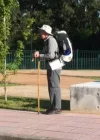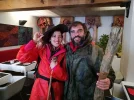I'll certainly NOT try to convert the hiking-sticks-disciples over to my point of view; 'twould be pointless. Instead, I'll just talk about MY use of a single hiking staff.
I've been trekking (hiking, nature-walking, birding, backpacking, what-have-you) for most of my life. I have found a single staff to be extremely useful because it (a) significantly aids my balance over rough terrain, either in contact with the ground or deployed horizontally like a high-wire walker, (b) makes me into an efficient, energy-saving "tripod" when pausing with pack still on my back, (c) serves to support the grounded backpack in such a way as to provide an excellent backrest during breaks, (d) is wonderful for retrieving potentially-lost articles, and more.
My current hiking staff is actually a camera monopod, sorta-kinda like this one:
https://www.google.com/express/prod...source=google_shopping&utm_medium=product_ads
(Mine is significantly cheaper and only has two extendable sections.)
My staff is length-adjustable from its stowage-length of 27 inches through "mere" walking cane height all the way to a full-height staff (in my case, six feet tall). I commonly use it as a binocular-prop to stabilize said optics when I'm viewing faraway objects. I have added my own custom wrist strap so as to provide additional support and stabilization when climbing uphill. The additional length also provides great tripod-like support and stabilization when going downhill.
Let us not forget to include its convenience as a field-expedient tent pole, etc.
Again, I'm not attempting to say that my hiking staff is in any way superior to hiking sticks. This is an extremely personal choice, after all.
-- Glenn
PS: Besides, as an earlier poster said, using a single staff frees up one hand to hold a bottle (wine, beer, etc.)....



























